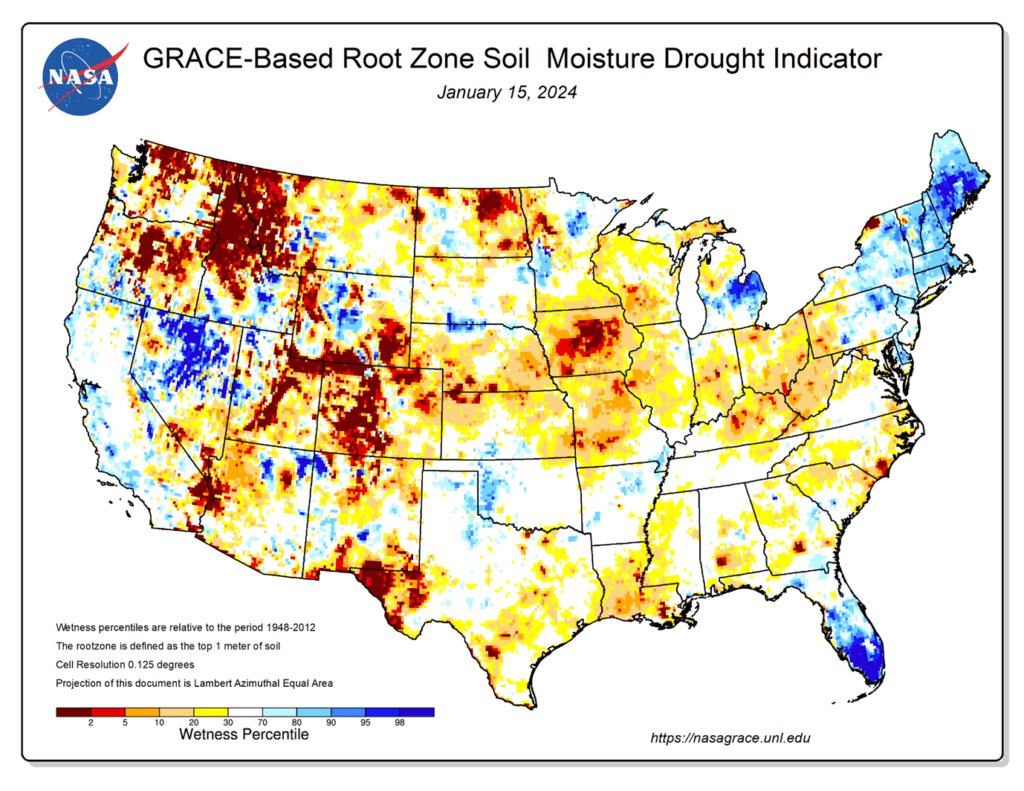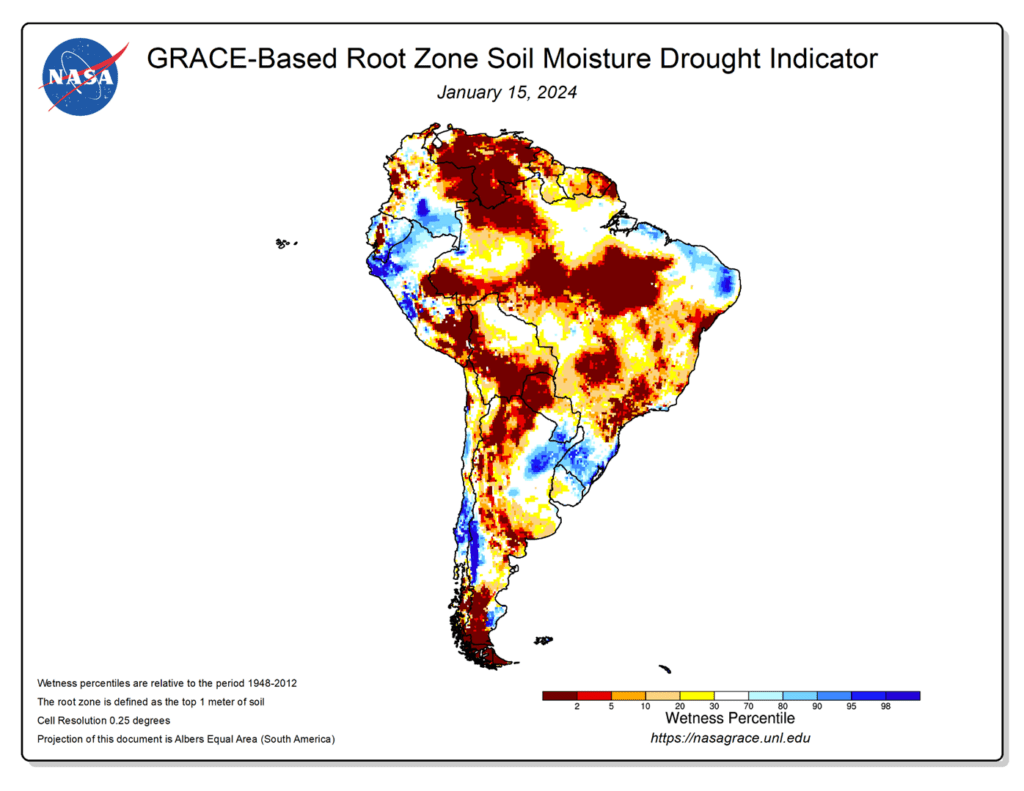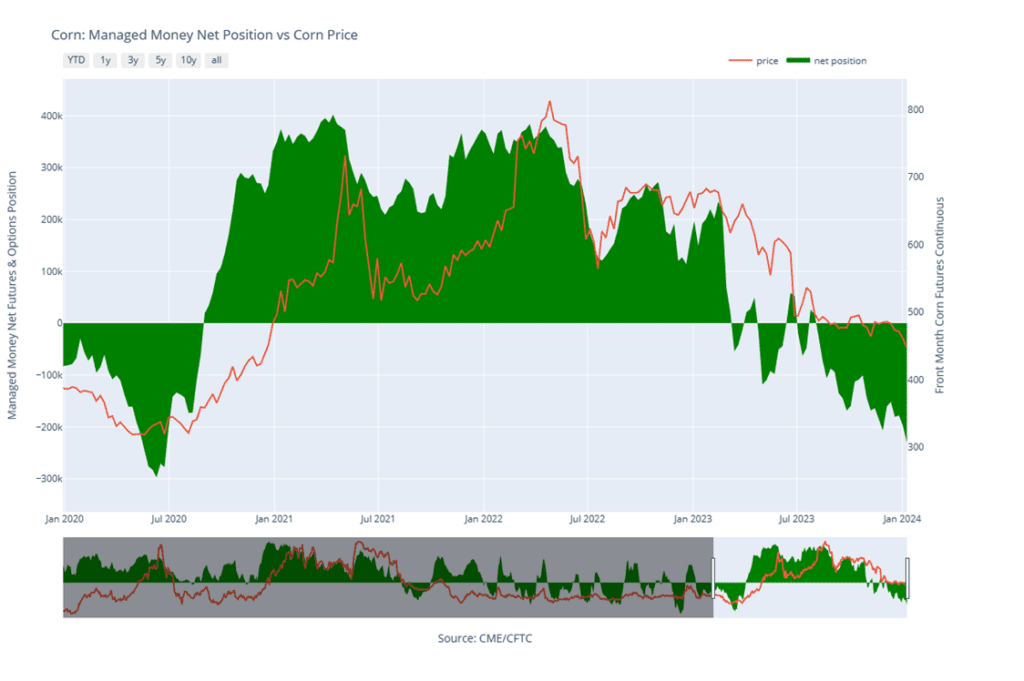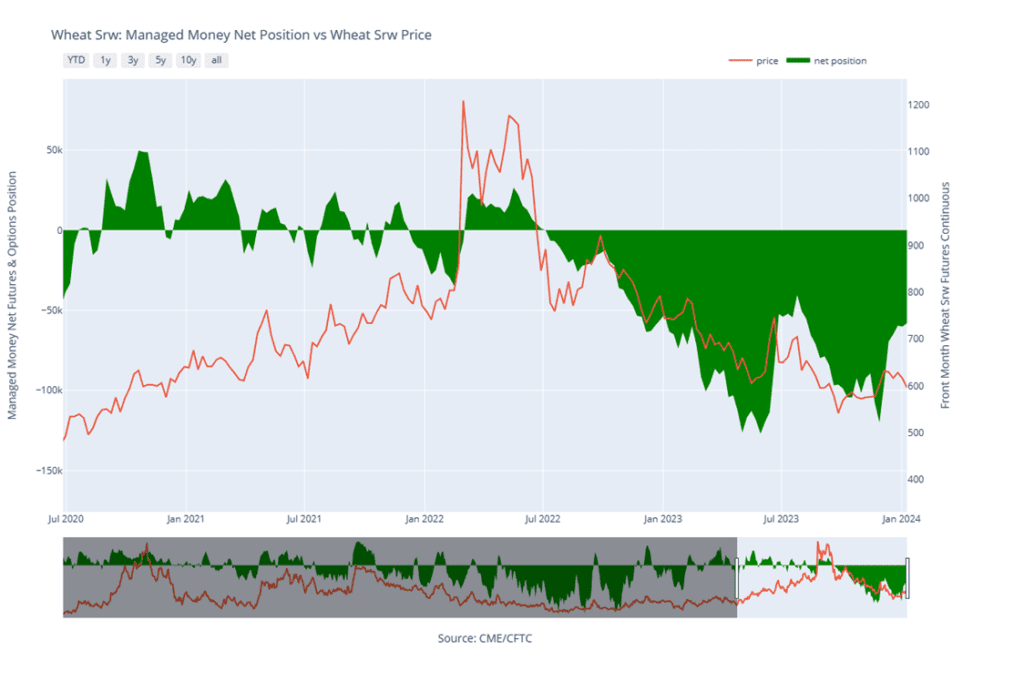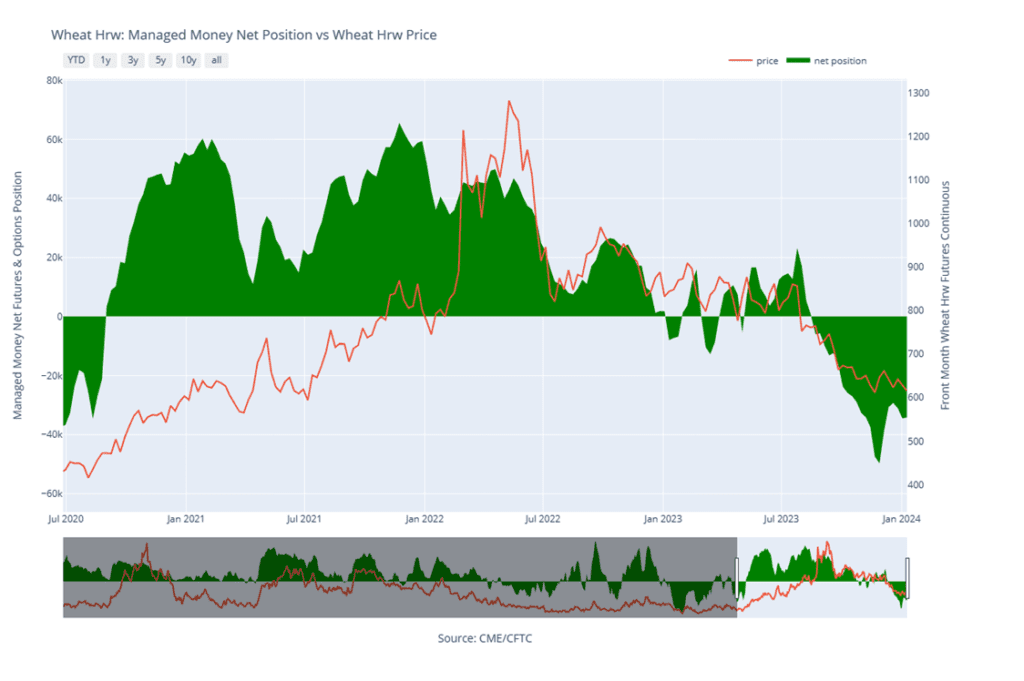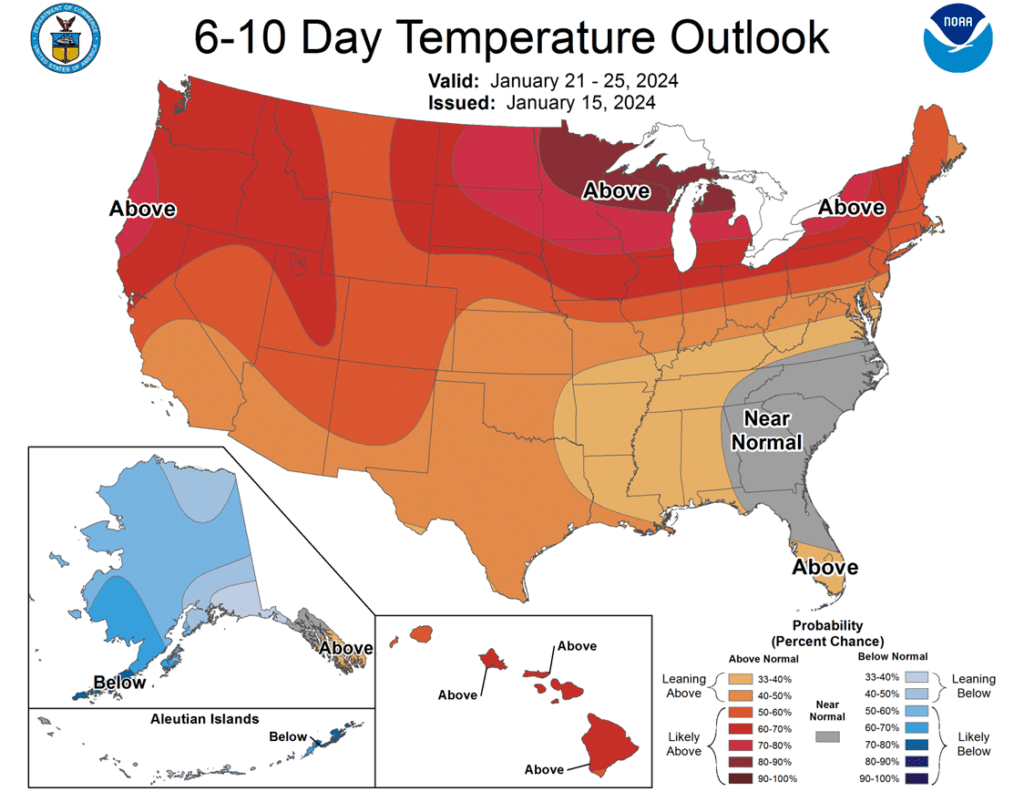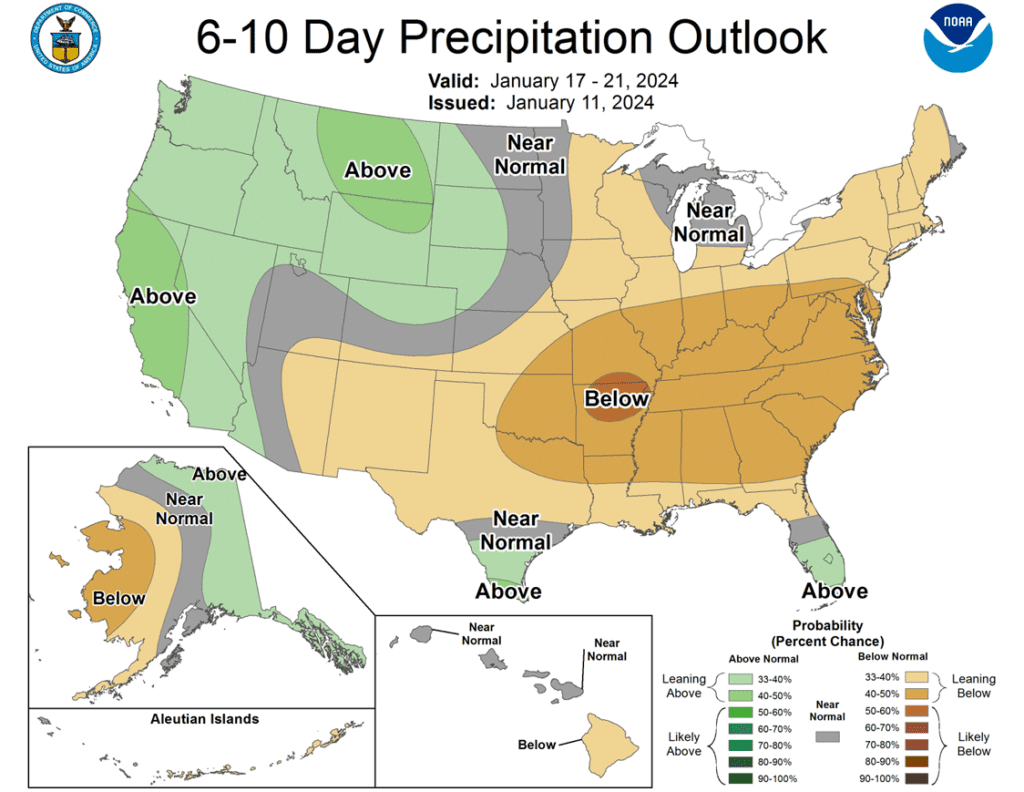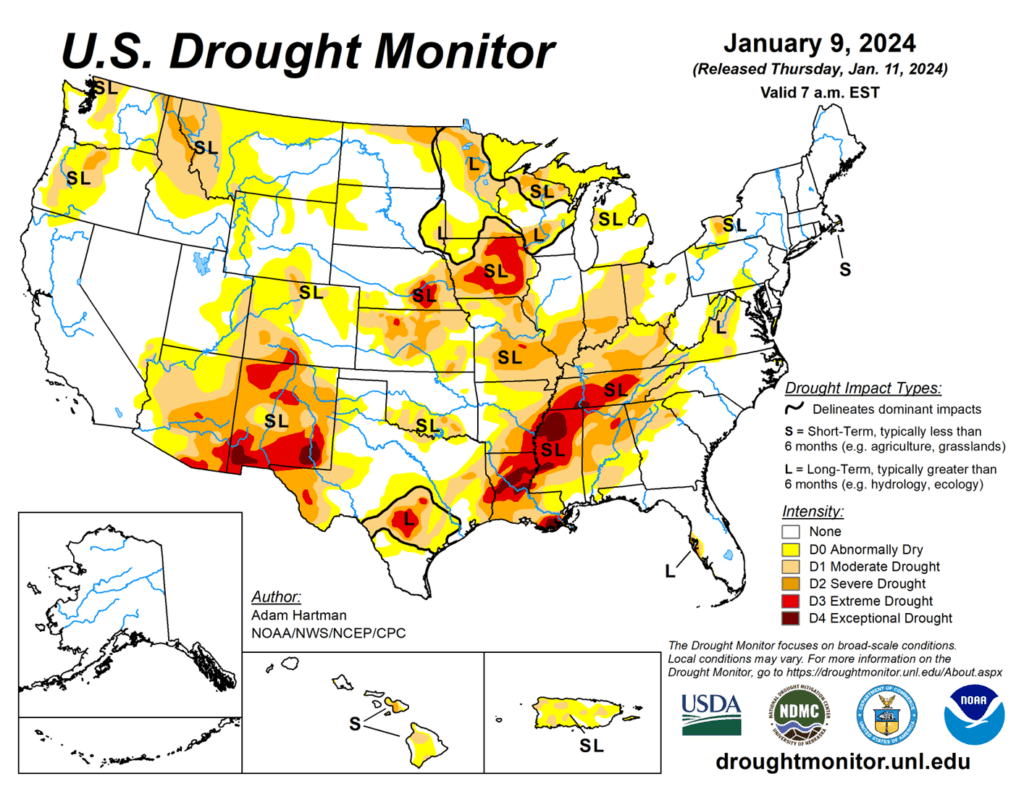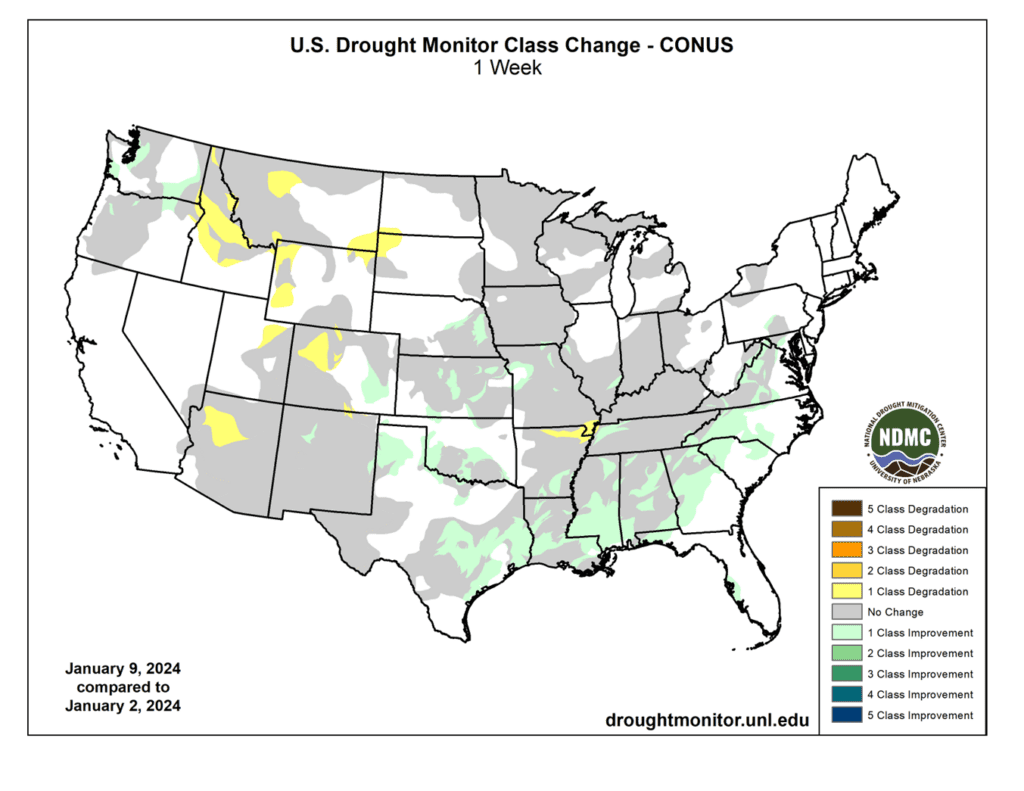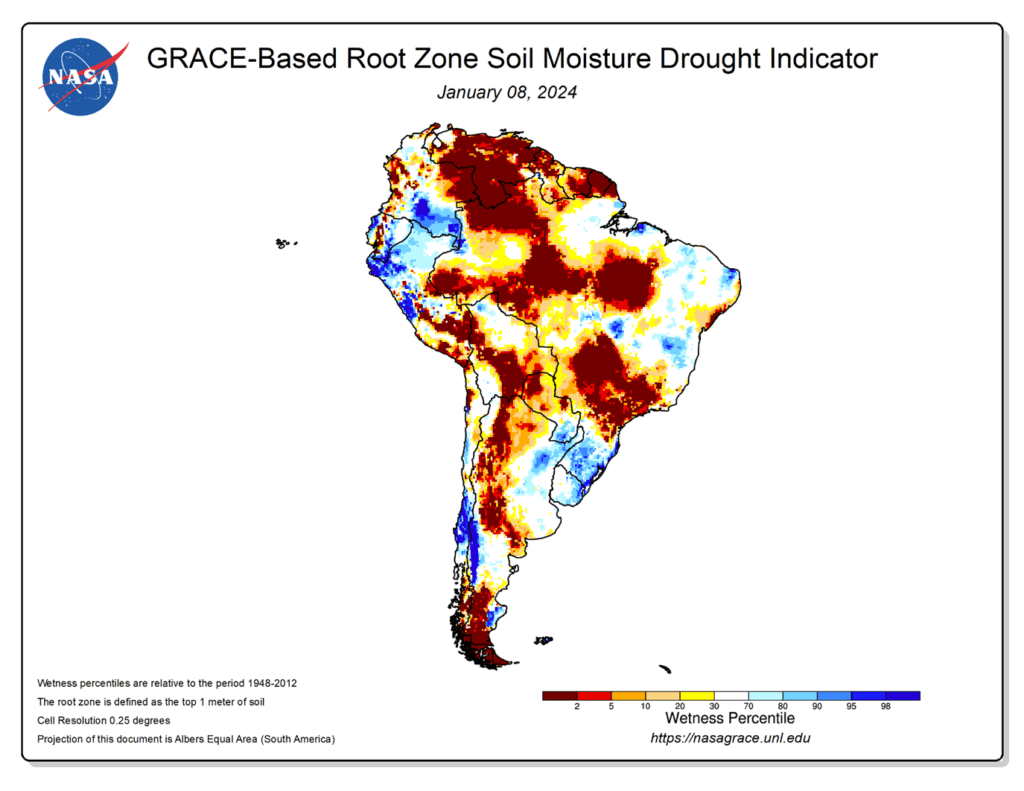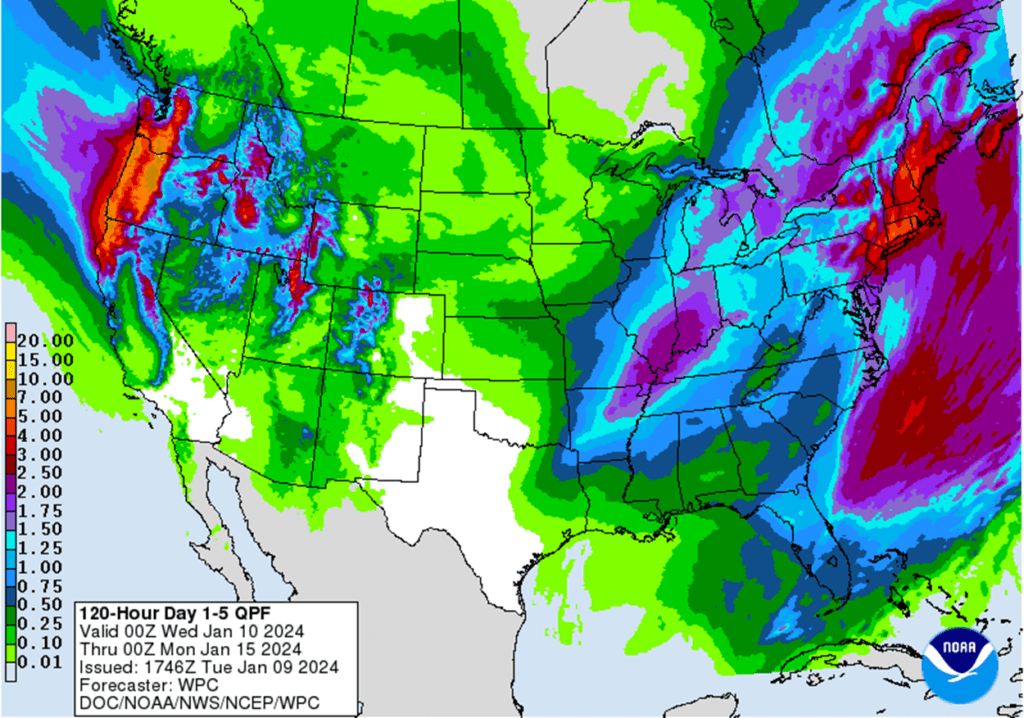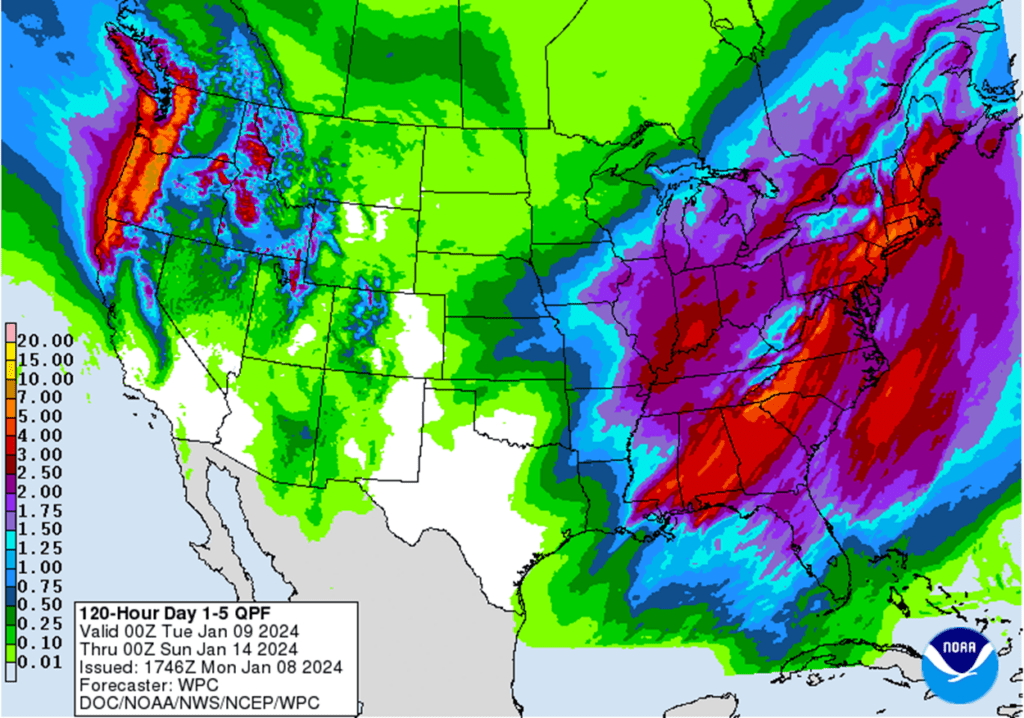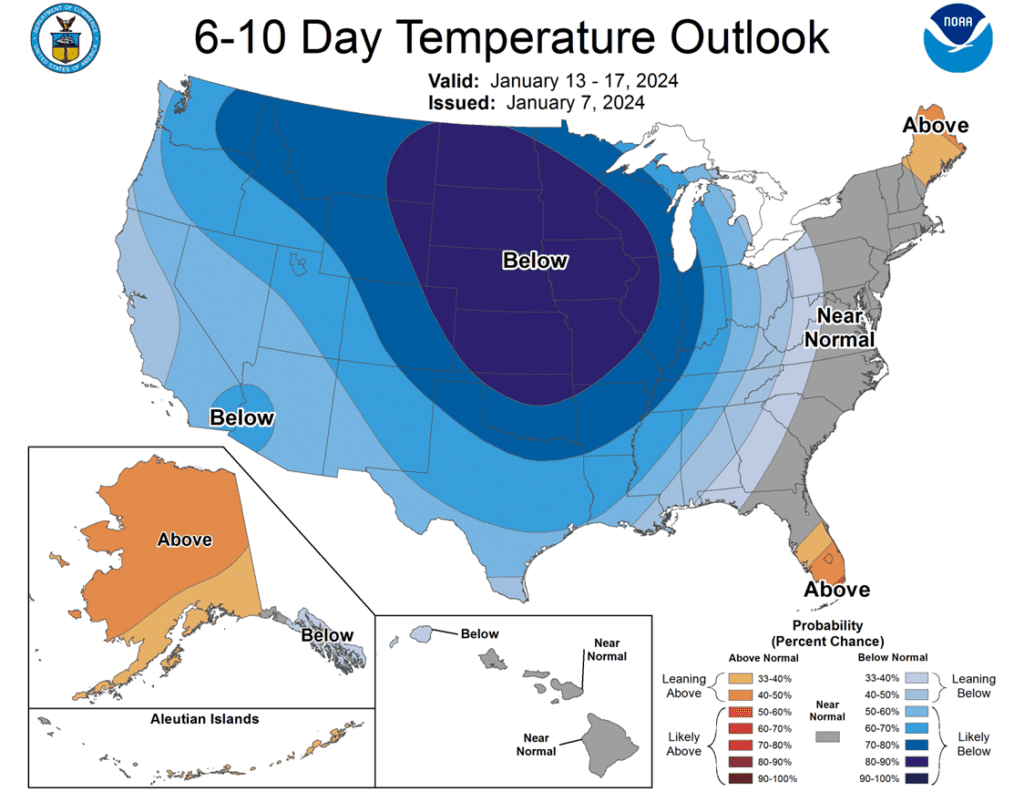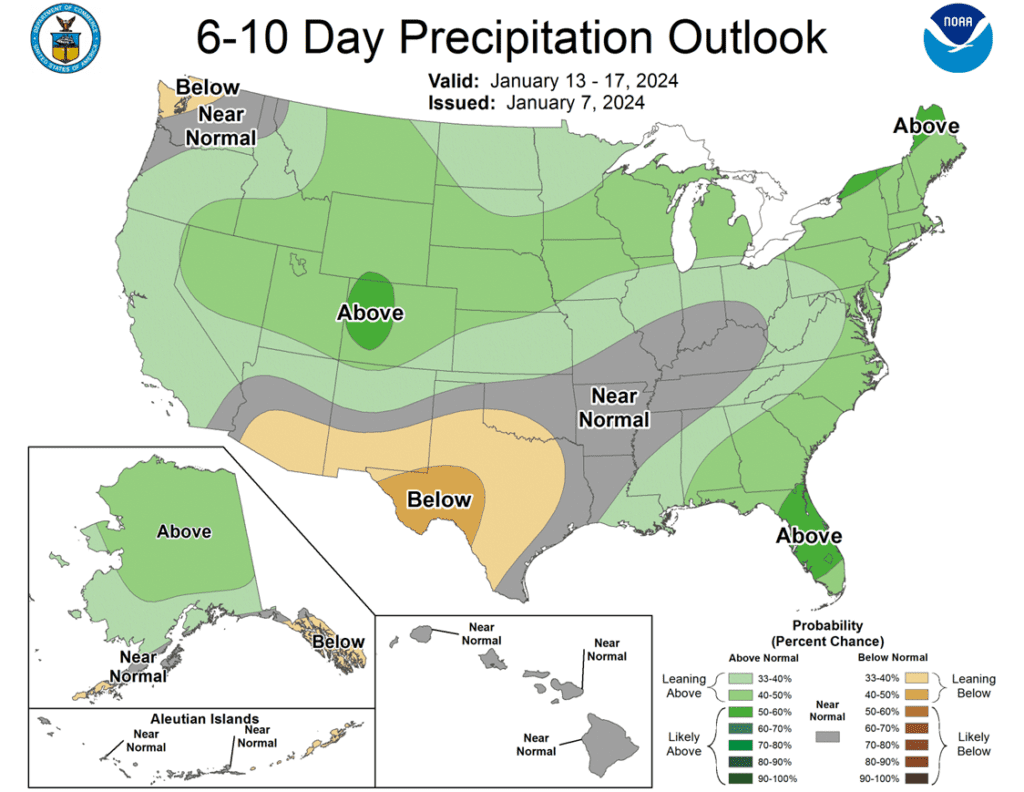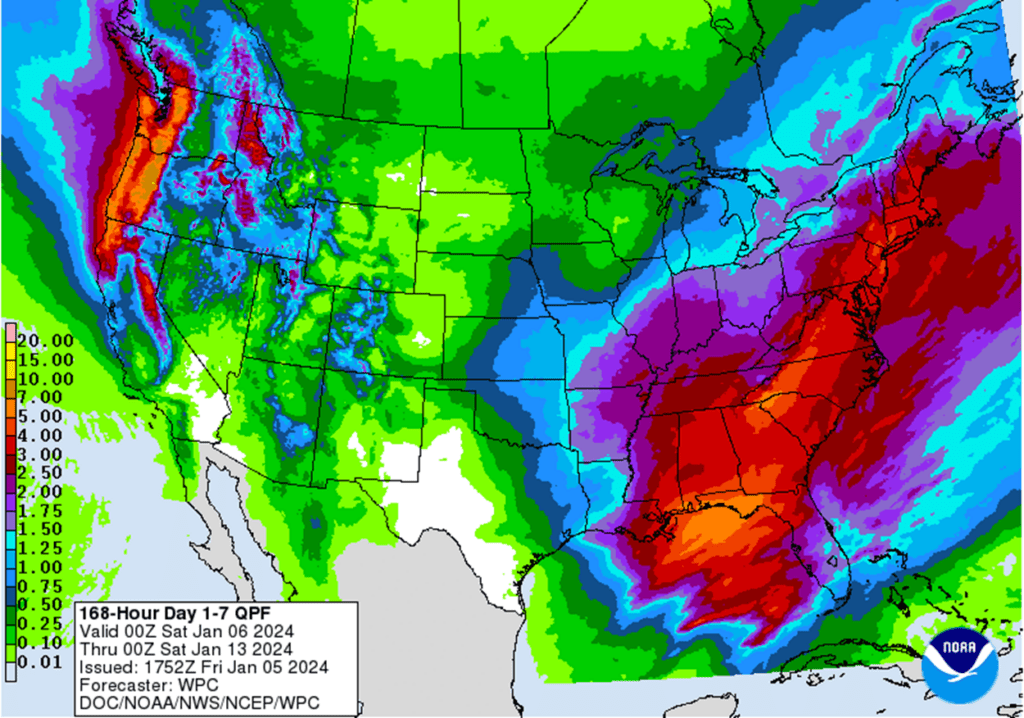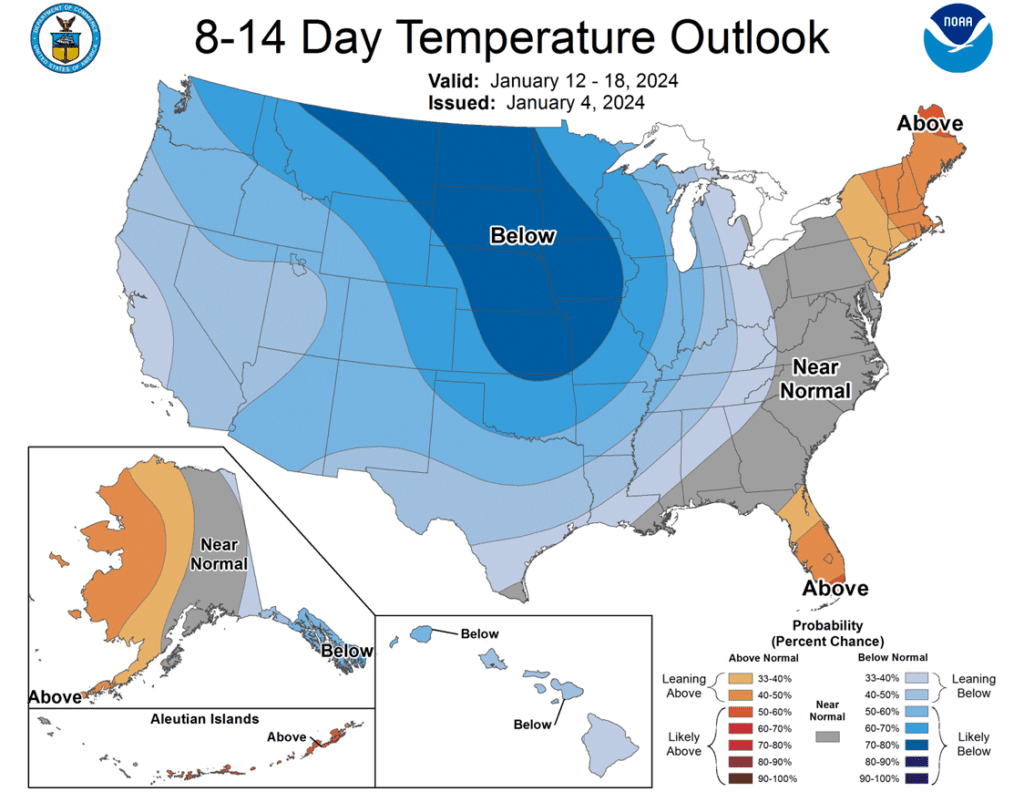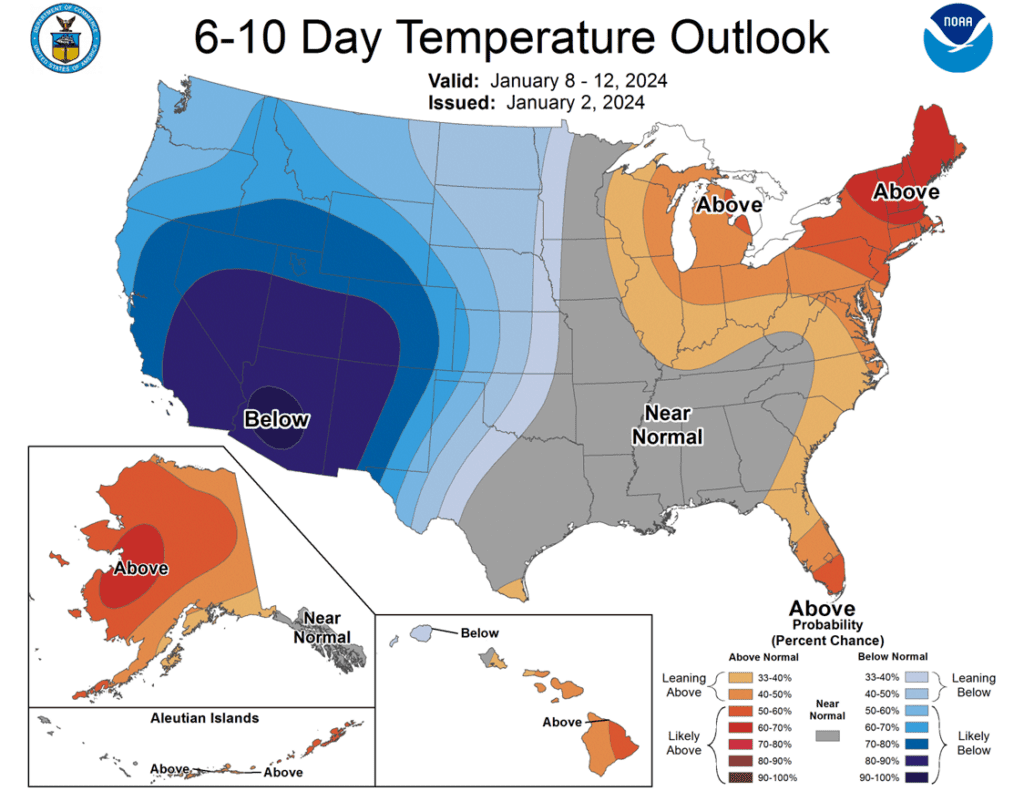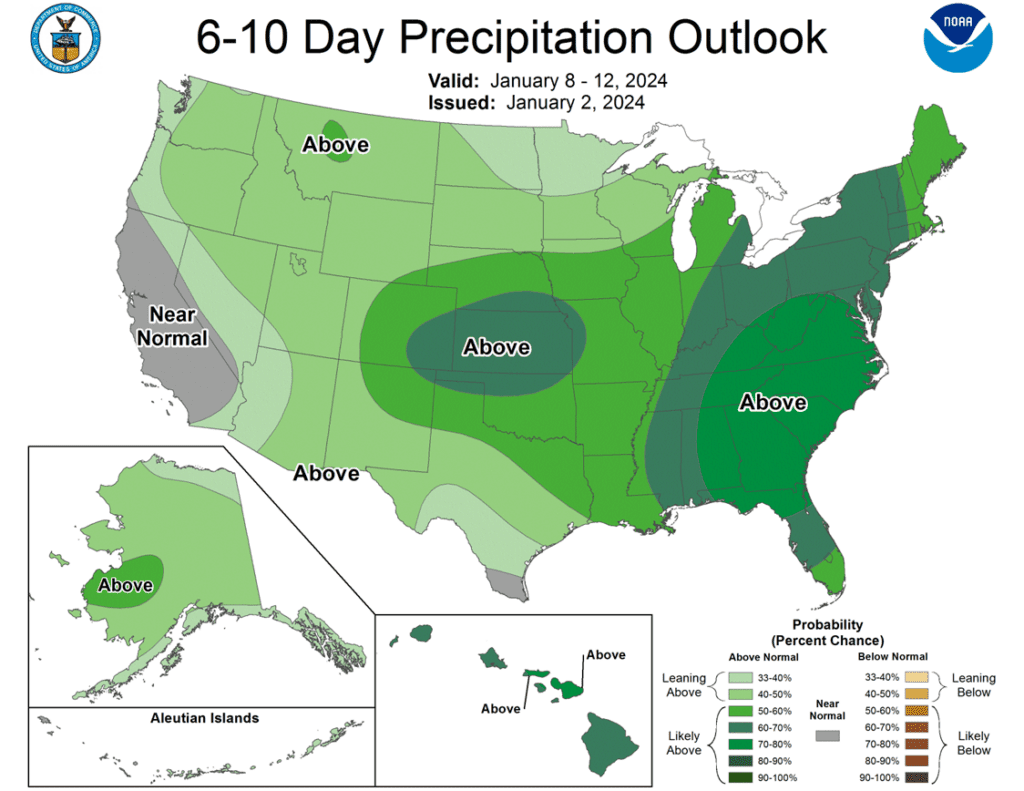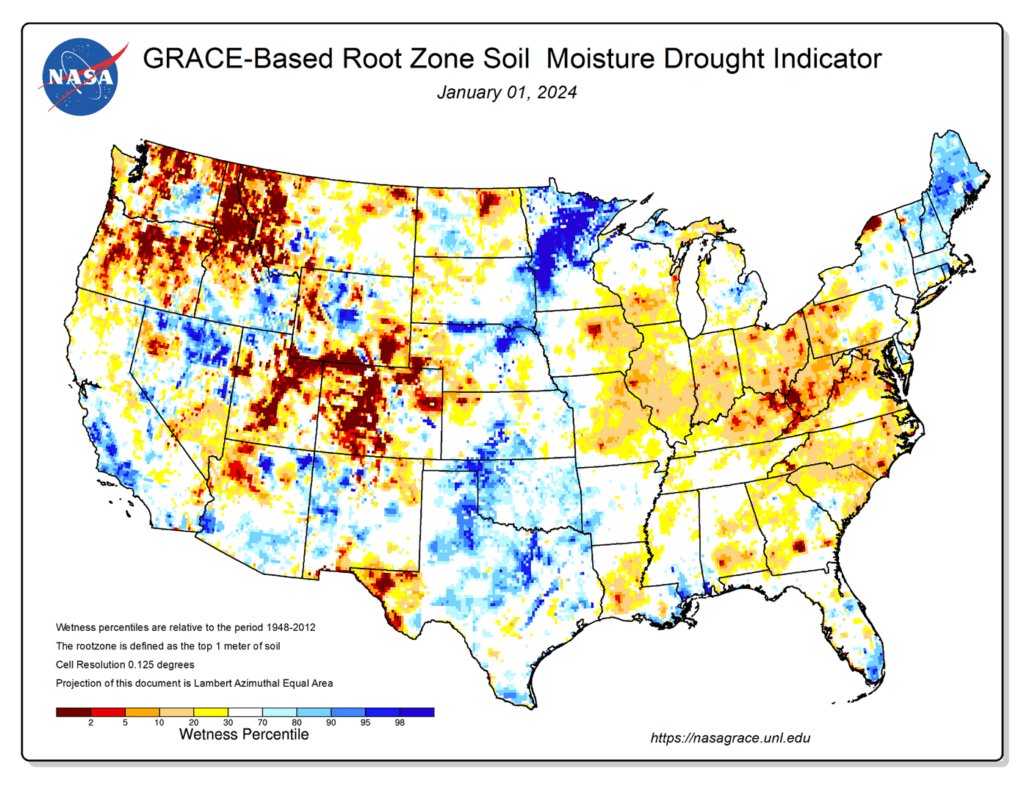01-17 End of Day: Weak Chinese Economic Data Presses Markets Lower
All prices as of 2:00 pm Central Time
Grain Market Highlights
- Spillover weakness from soybeans and a stronger US dollar weighed on the corn market that set a new contract low, and low close for March corn.
- Reports of a slowing Chinese economy and sharply lower soybean meal kept downward pressure on soybeans, which closed near the day’s lows following choppy trade that saw prices on both sides of unchanged.
- Talk of increasing Argentine soybean production that could exceed 52 mmt weighed heavily on soybean meal, which closed the day forming a bearish reversal. Soybean oil, on the other hand, settled in the green after making a new low for the move, possibly with help from crude oil, which also rallied off its lows.
- Unconfirmed rumors of Chinese vessels loading SRW wheat in the Gulf of Mexico may have added support to March Chicago wheat, which closed fractionally higher, while the complex as whole saw pressure from neighboring soybeans and a rising dollar to close mostly lower.
- To see the updated GRACE-based drought indicator maps of the US and South America, courtesy of the NDMC and NASA, scroll down to other Charts/Weather Section.
Note – For the best viewing experience, some Grain Market Insider content is best viewed with your phone held horizontally.
Corn
Corn Action Plan Summary
- No new action is recommended for 2023 corn. Front month corn has languished in a sideways to lower trend since printing a high in October, with a general lack of bullish news and an estimated US carryout over 2.1 billion bushels. The failure of the USDA’s January report to provide the bullish news necessary to turn prices higher is disappointing and the market remains at risk of remaining in the same pattern. With that being said, the market does show signs of being oversold, and managed funds hold a sizable net short position, which could trigger a short covering rally if a bullish catalyst enters the scene. For now, Grain Market Insider will continue to hold tight on any further sales recommendations for the next few weeks with the objective of seeking out better pricing opportunities. If the market has not turned around by then, Grain Market Insider may sit tight on the next sales recommendations until spring.
- No new action is recommended for 2024 corn. Following the January USDA Supply and Demand update, Dec ’24 broke through the bottom end of the 485 ¾ to 602 range that had been in place since February ’22. While this is a disappointing development, bear spreading has allowed Dec ’24 to maintain more of its value versus old crop, as traders attempt to price in a larger 2023 carryout with more uncertainty remaining for the 2024 crop. Additionally, Dec ’24 does show signs of being oversold, which is supportive if a bullish catalyst enters the scene. Grain Market Insider continues to watch for signs of a change in the current trend to look at recommending making additional sales and buying Dec ’24 call options.
- No Action is currently recommended for 2025 corn. Grain Market Insider isn’t considering any recommendations at this time for the 2025 crop that will be planted two springs from now. It will probably be late winter or early spring of 2024 before Grain Market Insider starts considering the first sales targets.
To date, Grain Market Insider has issued the following corn recommendations:
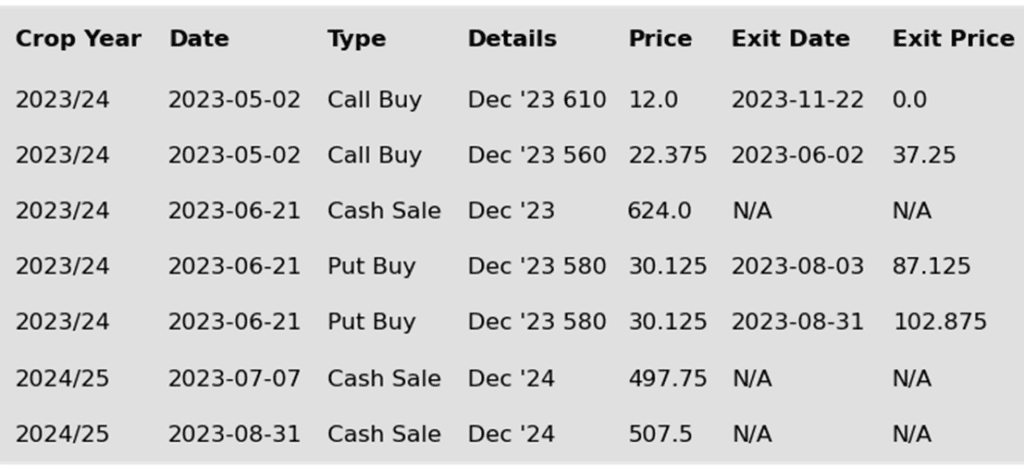
- Disappointing price action in the corn market, as prices failed to hold the session highs and finished with losses. March corn established a new contract low and low close, losing 1 ¼ cents on the session. Strong selling pressure in the soybean market and a surge higher in the US dollar weighed on corn prices on Tuesday.
- Technically, March corn futures failed to push back through the psychological 450 level, setting up the afternoon retest of the lows of the session. The negative price action and weak close will keep sellers active going into Thursday’s trade.
- China reported weak GDP data overnight, which triggered selling pressure across the commodity sector. The Chinese economy grew 5.2% in the fourth quarter, which had analysts concerned about the overall Chinese economy. The slower growth rate weighed heavily on soybeans and the rest of the commodity markets for the early part of the session.
- The soft price action showed that sellers are in control of the market, and any buying strength runs into selling pressure. Hedge Funds continue to push their large net short position in the corn market, now estimated to have over 250,000 contracts.
- The US Dollar Index has rallied steadily since the first of the year. The Dollar Index traded to its highest level in six weeks at the 103-basis point level. The stronger dollar limits US competitiveness for grains and weighed on prices.

Above: Earlier in January, March corn broke through 460 support, which is now nearby resistance, and retreated toward nearby support around 440. The market shows signs of being oversold, which can be supportive if bullish information enters the market. If prices break below 440, the next major support level comes in near 415. Overhead, if prices rally above 460, additional resistance may enter in between 470-480.
Soybeans
Soybeans Action Plan Summary
- No new action is recommended for 2023 soybeans. Front month soybeans recent downside breakout of the 1290 – 1400 range indicates that there is risk that prices may continue to retreat toward 1180, as forecasts for improved South American weather lessen the potential for the record large global carryout to be reduced. Given the potential of a downside breakout, Grain Market Insider recently recommended adding to sales as the current price level is still historically good. It’s been disappointing how the market has been unable to push higher despite the South American production concerns. Because of that, Grain Market Insider’s concern is that, if the weather pattern doesn’t remain adverse, the path of least resistance could be lower. Grain Market Insider will continue to look at additional sales opportunities, as well as potential re-ownership strategies.
- No new action is recommended for the 2024 crop. The Nov ’24 contract recently broke through the downside of the 1233 – 1320 range that has been in place since the end of July. With this downside breakout, and considering the bullish influence of adverse South American weather, which appears to be improving, Nov ’24 runs the risk of retreating towards 1150 unless another bullish catalyst enters the market. If prices find support and turn back higher, Grain Market Insider recently recommended buying Nov ’24 1280 and 1360 calls to give you confidence to make sales against anticipated 2024 production and to protect any sales in an extended rally. Grain Market Insider will also continue to watch for any sales opportunities.
- No Action is currently recommended for 2025 Soybeans. Grain Market Insider isn’t considering any recommendations at this time for the 2025 crop that will be planted two springs from now, and it may be some time before conditions are conducive to consider making any recommendations. Be patient as we monitor the markets for signs of improvement.
To date, Grain Market Insider has issued the following soybean recommendations:

- Soybeans ended the day sharply lower following poor GDP data out of China and a lack of Chinese demand for soybeans. Soybean meal was the biggest loser of the day, but soybean oil managed to end the day slightly higher.
- Yesterday, the NOPA crush report showed 195.33 million bushels of soybeans crushed in December, which was well above the average trade guess and a record for any month. The crush was up 10% year over year and up 5% from the prior December high. This should be supportive, but aggressive fund selling, and the South American harvest has pressured soybeans.
- Chinese GDP data showed about 5% annual growth for 2023, but their economic recovery is still seen as uneven and concerning. Some analysts are predicting that the Chinese economy will see another slowdown later this year, which could impact imports of agricultural goods.
- Soybean production in Brazil was estimated at 157 mmt by the USDA last week, but many analysts have that number at 150 mmt or below. The concerning thing has been the lack of soybean purchases by China from Brazil recently after China went on a buying spree last year.

Above: Soybeans have steadily retreated after leaving a 6-cent gap between 1290 ¾ and 1296 ¾. The market is showing signs of being extremely oversold, which can be supportive if bullish information enters the market to turn prices around. If prices do turn back higher, resistance rests around the price gap and again near the 50-day moving average. Otherwise, the next major support level comes in near the November ’21 low of 1181.
Wheat
Market Notes: Wheat
- Wheat attempted a rally today, with March Chicago up over a dime at one point. This could be tied to unconfirmed rumors that there are ships in the US Gulf loading SRW wheat to deliver to China. However, March Chicago ended up closing just a half cent higher, while the rest of the wheat contracts in all three classes settled with losses for the day.
- A combination of a higher US Dollar Index and sharply lower soybean futures likely weighed both wheat and corn today. Additionally, while about 20% of the US winter wheat crop was exposed to the recent cold temperatures, most are not expecting winterkill to be much of an issue. This may have offered some weakness to wheat, as there was some anticipation that crop damage would be a bullish factor.
- As of January 14, EU soft wheat exports reached 16.88 mmt since the season began in July. This compares with 18.17 mmt for the same timeframe last year, representing a roughly 7% decline year over year.
- According to FranceAgriMer, French soft wheat exports for 23/24 are estimated at 17.01 mmt, down from the previous estimate of 17.2 mmt. The stockpile projection also increased from 3.22 mmt to 3.43 mmt.
- As of January 17, Russia’s export duty on wheat has declined from 4,165.9 rubles per mt to 3,946.5 rubles. This represents a 5.3% decrease, and Russian wheat export values remain the world’s cheapest at $240 to $245 per mt. Despite these low prices, Algeria’s recent wheat purchase for up to 650,000 mt of wheat was sourced mainly from Europe.
Chicago Wheat Action Plan Summary
- No new action is currently recommended for 2023 Chicago wheat. The wheat market has continued to be dominated by lower world export prices that have stymied US export sales and depressed US prices. In early December, Grain Market Insider recommended taking advantage and making a sale on a short covering rally which was sparked by several Chinese purchases of US wheat. Since then, China has been silent in the US wheat export market, and prices remain somewhat elevated. Any remaining 2023 soft red winter wheat should be getting priced into market strength with the goal of having zero bushels unpriced by the end of January. Grain Market Insider won’t have any “New Alerts” for 2023 Chicago wheat – either Cash, Calls, or Puts, as we have moved focus onto 2024 and 2025 Crop Year Opportunities.
- No new action is recommended for 2024 Chicago wheat. Since early December, the July ’24 contract has traded mostly sideways to slightly lower after its brief short covering runup on Chinese buying. Although China has since been absent from the US wheat export market, managed funds continue to hold a sizeable, short position that could trigger another short covering rally if a bullish impetus enters the market. At the end of August, Grain Market Insider recommended purchasing July 590 puts to prepare for further price erosion. Back in June, Grain Market Insider recommended two separate sales that averaged about 720 to take advantage of the brief upswing. If the market receives the needed stimulus to move prices back toward this summer’s highs, Grain Market Insider is prepared to recommend adding to current sales levels and possibly even purchasing call options to protect those sales. Otherwise, the current recommended put position will add a layer of protection if prices erode further, and Grain Market Insider will be prepared to recommend covering some of those puts to offset much of the original cost and move toward a net neutral cost for the remaining position.
- No action is currently recommended for 2025 Chicago Wheat. Since early September, the July ’25 contract has been rangebound, largely between 650 on the bottom and 675 on the top. Grain Market Insider’s strategy for the 2025 crop year up to this point has been to sit tight. Though if prices break out of the topside of this range toward the 690 – 705 area, we will consider taking advantage of the rally and making sales recommendations.
To date, Grain Market Insider has issued the following Chicago wheat recommendations:
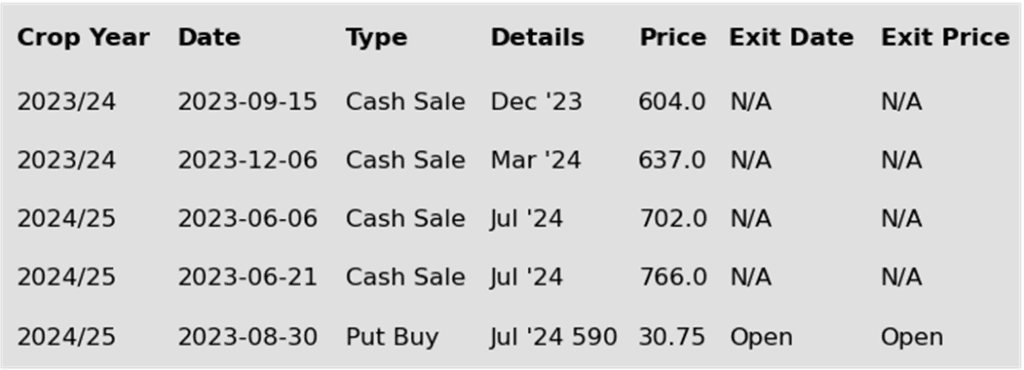

Above: The March contract’s closing through the bottom end of the recent range and 100-day moving average lends a bearish tilt to the market, which runs the risk of drifting lower toward the next major level of support near 556. If a bullish catalyst enters the market to turn prices higher, overhead resistance remains near 650.
KC Wheat Action Plan Summary
- No new action is recommended for 2023 KC wheat crop. After posting an 80-cent rally in late November and early December, front month KC wheat has languished and drifted lower while retracing about 50% of the upward move. Managed funds continue to carry a significant short position, and even though bullish headwinds like weak US demand and low world wheat prices remain, this could fuel a return to higher prices as winter weather risks add volatility to the market. Grain Market Insider’s strategy is to look for price appreciation this winter, as weather becomes a more prominent market mover, and may consider suggesting additional sales if prices become over-extended.
- No new action is recommended for 2024 KC wheat. At the end of August, the July ’24 contract broke out of roughly a one-year trading range and stepped down to a 609 ¼ low in late November, largely driven by managed fund selling in the front month on weak US export demand and lower world wheat prices. Since then, the funds covered part of their large short position which also rallied prices in the July ’24 contract. While bearish headwinds remain, managed funds continue to hold a sizable, short position, and price seasonals remain positive for adding weather risk premium. These are two factors that could fuel additional short covering and rally prices in the months ahead. Back in August, Grain Market Insider recommended buying Jul’24 KC wheat 660 puts to protect the downside following the range breakout. As the market recently got further extended into oversold territory and the July contract showed signs of support near 630, Grain Market Insider recommended exiting 75% of the originally recommended position. Moving forward, Grain Market Insider is prepared to recommend exiting the last 25% on any further supportive market developments.
- No action is currently recommended for 2025 KC Wheat. Grain Market Insider isn’t considering any recommendations at this time for the 2025 crop that will be planted next fall. It will probably be mid-winter before Insider starts considering the first sales targets.
To date, Grain Market Insider has issued the following KC recommendations:


Above: March KC wheat rejected an attempt to move higher near 650 and turned lower to test the bottom end of the recent range around 619. If the market continues to retreat, the next area of support remains near 595 and 575. Overhead, nearby resistance comes in around 650 and again between 675 – 680.
Mpls Wheat Action Plan Summary
- No new action is currently recommended for the 2023 New Crop. For much of the second half of last year, driven mostly by fund selling and slow US export demand, front month Minneapolis wheat slowly stair-stepped lower until hitting the November low. During this time, managed funds also established a record net short position. Since then, with the market mostly sideways, the November low of 697 ½ has held, and prices have pierced the 50-day moving average just once. Although bearish headwinds remain, the large fund net short position could fuel a short-covering rally if a bullish catalyst enters the scene to move prices to close above the 50-day moving average. Back in June, Grain Market Insider made a sales recommendation during the July rally near 820, and with that sale in place, Grain Market Insider’s strategy is to look for price appreciation this winter with an eye on considering additional sales around 725 – 775, and again north of 800.
- No new action is recommended for 2024 Minneapolis wheat. After trading to a peak of 871 ¾ last August, the Sept ’24 gradually retreated to a low in November in concert with the front month as managed funds built a record large net short position mostly on weak US export demand. And while Sept ’24 has failed to close above the 50-day moving average since late August, the 726 ¼ November low remains intact. Although bearish headwinds remain, the large fund net short position could fuel a short-covering rally if prices move higher and close above the 50-day moving average. Back in August, Grain Market Insider recommended buying July ’24 KC wheat 660 puts to protect the downside following a 1-year range breakout in KC wheat, and in November recommended exiting 75% of the originally recommended position as July ’24 KC wheat showed signs of support around 630. While in the same time frame, Grain Market Insider also recommended making an additional sale as the Sept ’24 Minneapolis contract broke long time 743 support. For now, Grain Market Insider remains prepared to recommend exiting the last 25% of the open puts on any further supportive market developments.
- No action is currently recommended for the 2025 Minneapolis wheat crop. Grain Market Insider isn’t considering any recommendations at this time for the 2025 crop that will be planted two springs from now. It will probably be mid-winter before Grain Market Insider starts considering the first sales targets.
To date, Grain Market Insider has issued the following Minneapolis wheat recommendations:


Above: The breach of 700 in the March contract could indicate further weakness with the next area of major support down near 669. The market does show signs of being oversold, which is supportive if the market turns back higher. Overhead initial resistance lies around 700 and then again between 721 and 734.
Other Charts / Weather
